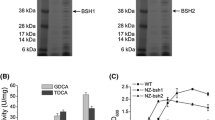Abstract
The effect of the conjugated bile acid (BA) on the microbial internal pH (pHin) values in lactic acid bacteria with and without ability to hydrolyze bile salts (BSH[+] and BSH[−] strains, respectively) was evaluated. BSH(+) strains showed a gradual increase in the pHin following the addition of conjugated BA; this behavior was more pronounced with GDCA than with TDCA may be due to the higher affinity of BSH for the glyco-conjugates acids. Conversely, the BSH(−) strains showed a decrease in internal pH probably as a consequence of weak acid accumulation. As expected, a decrease in the cytoplasmatic pH affected the cell survival in this last group of strains, while the BSH(+) strains were more resistant to the toxic effect of BA.
Purpose of work
To evaluate bile salt hydrolase activities, changes in the internal pH and cell survival to bile acids in lactic acid bacteria to establish the relationship between these parameters.

Similar content being viewed by others
References
Begley M, Sleator RD, Gahan CG, Hill C (2005) Contribution of three bile-associated loci, bsh, pva, and btlB, to gastrointestinal persistence and bile tolerance of Listeria monocytogenes. Infect Immun 73:894–904
Begley M, Hill C, Gahan CG (2006) Bile salt hydrolase activity in probiotics. Appl Environ Microbiol 72:1729–1738
Bixquert JM (2009) Treatment of irritable bowel syndrome with probiotics. An etiopathogenic approach at last? Rev Esp Enferm Dig 101:553–564
Bustos AY, Raya R, de Valdez GF, Taranto MP (2011) Efflux of bile acids in Lactobacillus reuteri is mediated by ATP. Biotechnol Lett 33:2265–2269
Church FC (1985) An o-phthalaldehyde spectrophotometric assay for proteolytic enzymes. Prog Clin Biol Res 180:303–305
de Moreno de Leblanc A et al (2011) Importance of IL-10 modulation by probiotic microorganisms in gastrointestinal inflammatory diseases. ISRN Gastroenterol 2011:892971. doi:10.5402/2011/892971
De Smet I, Van Hoorde L, Vande Woestyne M, Christiaens H, Verstraete W (1995) Significance of bile salt hydrolytic activities of lactobacilli. J Appl Bacteriol 79:292–301
Dussurget O et al (2002) Listeria monocytogenes bile salt hydrolase is a PrfA-regulated virulence factor involved in the intestinal and hepatic phases of listeriosis. Mol Microbiol 45:1095–1106
Elkins CA, Mullis LB (2004) Bile-mediated aminoglycoside sensitivity in Lactobacillus species likely results from increased membrane permeability attributable to cholic acid. Appl Environ Microbiol 70:7200–7209
Fang F et al (2009) Allelic variation of bile salt hydrolase genes in Lactobacillus salivarius does not determine bile resistance levels. J Bacteriol 191:5743–5757
FAO/WHO (2002) Drafting guidelines for the evaluation of probiotics in foods. Report of a Joint FAO/WHO Working Group, London, Ontario, Canada. http://www.who.int/foodsafety/fs_management/en/probiotic_guidelines.pdf. Retrieved 30 April 2002 and May 1 2002
Grill JP, Perrin S, Schneider F (2000) Bile salt toxicity to some bifidobacteria strains: role of conjugated bile salt hydrolase and pH. Can J Microbiol 46:878–884
Hamon E et al (2012) Investigation of biomarkers of bile tolerance in Lactobacillus casei using comparative proteomics. J Proteome Res 11:109–118
Hylemon PB, Stellwag EJ (1976) Bile acid biotransformation rates of selected gram-positive and gram-negative intestinal anaerobic bacteria. Biochem Biophys Res Commun 69:1088–1094
Jensen H, Grimmer S, Naterstad K, Axelsson L (2012) In vitro testing of commercial and potential probiotic lactic acid bacteria. Int J Food Microbiol 153:216–222
Kobayashi H, Suzuki T, Kinoshita N, Unemoto T (1984) Amplification of the Streptococcus faecalis proton-translocating ATPase by a decrease in cytoplasmic pH. J Bacteriol 158:1157–1160
Kurdi P, Tanaka H, Van Veen HW, Asano K, Tomita F, Yokota A (2003) Cholic acid accumulation and its diminution by short-chain fatty acids in bifidobacteria. Microbiology 149:2031–2037
Kurdi P, Kawanishi K, Mizutani K, Yokota A (2006) Mechanism of growth inhibition by free bile acids in lactobacilli and bifidobacteria. J Bacteriol 188:1979–1986
Lee J et al (2011) Evaluation of probiotic characteristics of newly isolated Lactobacillus spp.: immune modulation and longevity. Int J Food Microbiol 148:80–86
Lundeen SG, Savage DC (1992) Characterization of an extracellular factor that stimulates bile salt hydrolase activity in Lactobacillus sp. strain 100-100. FEMS Microbiol Lett 73:121–126
Masood MI, Qadir MI, Shirazi JH, Khan IU (2011) Beneficial effects of lactic acid bacteria on human beings. Crit Rev Microbiol 37:91–98
McAuliffe O, Cano RJ, Klaenhammer TR (2005) Genetic analysis of two bile salt hydrolase activities in Lactobacillus acidophilus NCFM. Appl Environ Microbiol 71:4925–4929
Salmond CV, Kroll RG, Booth IR (1984) The effect of food preservatives on pH homeostasis in Escherichia coli. J Gen Microbiol 130:2845–2850
Slonczewski JL, Fujisawa M, Dopson M, Krulwich TA (2009) Cytoplasmic pH measurement and homeostasis in bacteria and archaea. Adv Microb Physiol 55:1–79, 317. doi:10.1016/S0065-2911(09)05501-5
Tanaka H, Doesburg K, Iwasaki T, Mierau I (1999) Screening of lactic acid bacteria for bile salt hydrolase activity. J Dairy Sci 82:2530–2535
Tannock GW, Dashkevicz MP, Feighner SD (1989) Lactobacilli and bile salt hydrolase in the murine intestinal tract. Appl Environ Microbiol 55:1848–1851
Taranto MP, Sesma F, Valdez GF (1999) Localization and primary characterization of bile salt hydrolase activity from Lactobacillus reuteri. Biotechnol Lett 21:935–938
Usman HA (1999) Bile tolerance, taurocholate deconjugation, and binding of cholesterol by Lactobacillus gasseri strains. J Dairy Sci 82:243–248
Acknowledgments
This project was supported by grants of CONICET, FONCyT and CIUNT from Argentina.
Author information
Authors and Affiliations
Corresponding author
Rights and permissions
About this article
Cite this article
Bustos, A.Y., Saavedra, L., de Valdez, G.F. et al. Relationship between bile salt hydrolase activity, changes in the internal pH and tolerance to bile acids in lactic acid bacteria. Biotechnol Lett 34, 1511–1518 (2012). https://doi.org/10.1007/s10529-012-0932-5
Received:
Accepted:
Published:
Issue Date:
DOI: https://doi.org/10.1007/s10529-012-0932-5




